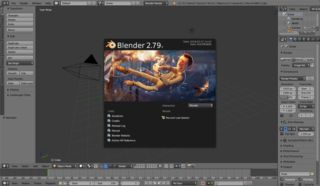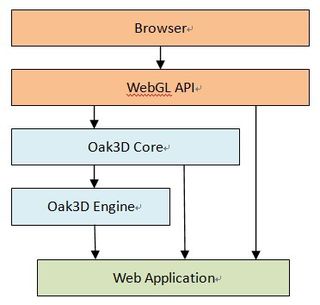
Blender is a free and open-source 3D computer graphics software toolset used for creating animated films, visual effects, art, 3D printed models, interactive 3D applications and video games. Blender's features include 3D modeling, UV unwrapping, texturing, raster graphics editing, rigging and skinning, fluid and smoke simulation, particle simulation, soft body simulation, sculpting, animating, match moving, rendering, motion graphics, video editing and compositing.

Crystal Space is a framework for developing 3D applications written in C++ by Jorrit Tyberghein and others. The first public release was on August 26, 1997. It is typically used as a game engine but the framework is more general and can be used for any kind of 3D visualization. It is very portable and runs on Microsoft Windows, Linux, UNIX, and Mac OS X. It is also free and open-source software, licensed under the GNU Lesser General Public License, and was SourceForge.net's Project of the Month for February 2003.

A particle system is a technique in game physics, motion graphics, and computer graphics that uses a large number of very small sprites, 3D models, or other graphic objects to simulate certain kinds of "fuzzy" phenomena, which are otherwise very hard to reproduce with conventional rendering techniques - usually highly chaotic systems, natural phenomena, or processes caused by chemical reactions.
Irrlicht is an open-source game engine written in C++. It is cross-platform, officially running on Windows, macOS, Linux and Windows CE and due to its open nature ports to other systems are available, including FreeBSD, Xbox, PlayStation Portable, Symbian, iPhone and Google Native Client.

Houdini is a 3D animation software application developed by Side Effects Software Inc (SESI) based in Toronto. SESI adapted Houdini from the PRISMS suite of procedural generation software tools. Its exclusive attention to procedural generation distinguishes it from other 3D computer graphics software.

Autodesk Softimage, or simply Softimage is a discontinued 3D computer graphics application, for producing 3D computer graphics, 3D modeling, and computer animation. Now owned by Autodesk and formerly titled Softimage|XSI, the software has been predominantly used in the film, video game, and advertising industries for creating computer generated characters, objects, and environments.

Truevision3D is a commercial computer software 3D engine first created by Sylvain Dupont in 1999.

The Blender Game Engine is a component of Blender, a free and open-source 3D production suite, used for making real-time interactive content. The game engine was written from scratch in C++ as a mostly independent component, and includes support for features such as Python scripting and OpenAL 3D sound.
Unigine is a proprietary cross-platform game engine, developed by Russian software company Unigine Corp. Apart from its use as a game engine, it is used for virtual reality systems, serious games and visualization. The strongest feature of Unigine is its advanced renderer which currently supports OpenGL 4.0 and DirectX 11. An updated Unigine SDK is released monthly.
Panda3D is a game engine that includes graphics, audio, I/O, collision detection, and other abilities relevant to the creation of 3D games. Panda3D is free software under the revised BSD license.
Visualization Library (VL) is an open source C++ middleware for 2D/3D graphics applications based on OpenGL 4, designed to develop portable applications for the Microsoft Windows, Linux and Mac OS X operating systems.

Away3D is an open-source platform for developing interactive 3D graphics for video games and applications, in Adobe Flash or HTML5. The platform consists of a 3D world editor, a 3D graphics engine, a 3D physics engine and a compressed 3D model file format (AWD).

Oak3D is a free JavaScript library for 3D graphics development based on the HTML5 WebGL standard, dedicated in realizing the Web3D applications with GPU acceleration for all the front-end developers in an easy and efficient way.
CopperLicht is an open-source JavaScript library for creating games and interactive 3D applications using WebGL, developed by Ambiera. The aim of the library is to provide an API for making it easier developing 3D content for the web. It is supposed to be used together with its commercial 3D world editor CopperCube, but it can also be used without.

StormEngineC is a 3D graphics library written in JavaScript and using several HTML5 features like WebGL, WebCL and WebSockets. It provides an easy way to load objects in OBJ and Collada format and add the physical simulation for them. The source code is free and is hosted in GitHub.

Horde3D is an open-source cross-platform graphics engine. Its purpose and design is similar to that of OGRE with the primary goal being lightweight for next-generation video games. The engine is also particularly suited for large crowd simulations. The engine is also compatible with GLFW. The major part of the graphics engine was originally written for the indie group pyropix and development is now continued at the University of Augsburg.

Godot is a 2D and 3D cross-platform compatible game engine released as open source software under the MIT license. It was initially developed for several companies in Latin America before its public release. The development environment runs on Linux, macOS, Windows, BSD and Haiku and can create games targeting PC, mobile and web platforms.

Blend4Web is a free and open source framework for creating and displaying interactive 3D computer graphics in web browsers.











